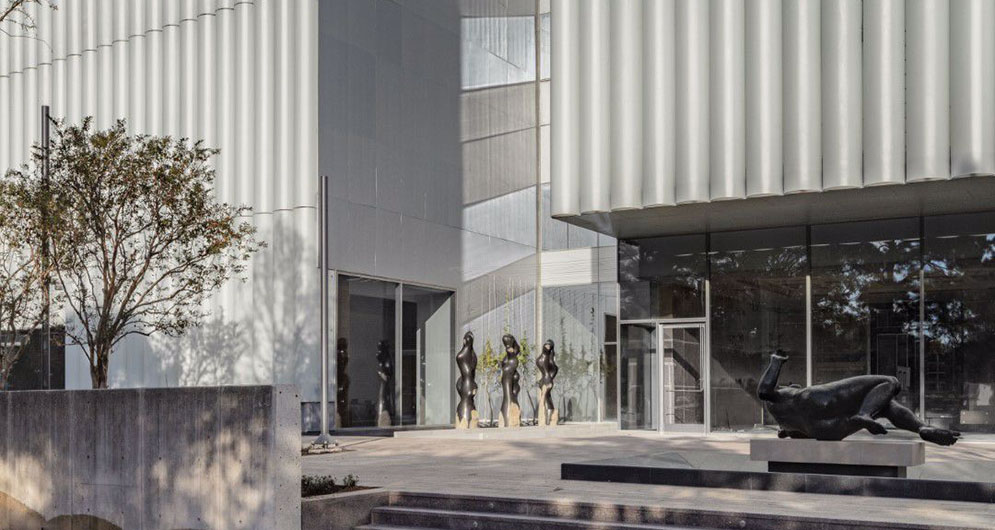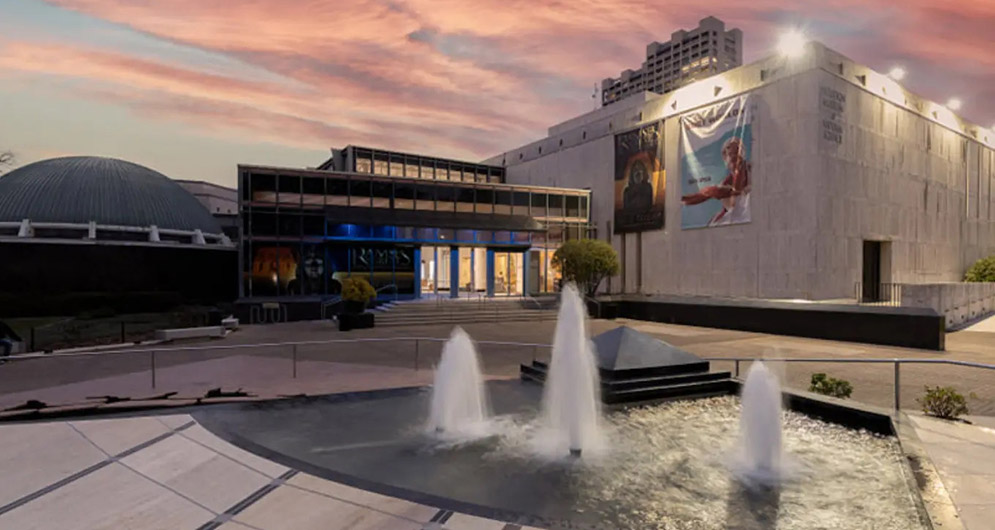There’s something captivating about a neighborhood where every building is a work of art—and not just because of what’s inside. Houston’s Museum District is one of those rare places where architecture and curation collaborate to create an experience. Every block invites you to wander, linger, and wonder.
My exploration began in the early afternoon on a crystal-clear day, when low winter sunlight filtered through bare trees, casting soft shadows on limestone façades. The crisp air held the faint echo of footsteps in marble hallways. With over twenty institutions and clusters of public art and gardens, the Museum District feels like a living canvas.
First Stop: The Museum of Fine Arts, Houston (MFAH)
Located just a short walk from Hermann Park, MFAH is one of the most expansive visual arts museums in the country. Its architecture is as impressive as its collection. A series of seamlessly connected pavilions, each with its own design, allows for fluid exploration. As I passed through the glass-enclosed sculpture court and across shaded courtyards, I felt grounded in both tradition and innovation.
Inside, galleries span Egyptian antiquities, European classics, Impressionists, African art, and contemporary installations. I paused in the modern wing before a large-scale installation of suspended glass beads and light. The subtle interplay of color and motion felt meditative. Staff provided insight without hovering; clean maps and friendly directions helped me navigate several buildings with ease.

Across the Street: Moores Opera House at MFAH
Although not a traditional museum, this Beaux‑Arts opera venue is architecturally splendid and deserves a stroll-around. Grand staircases, chandeliered foyers, and decorative plasterwork evoke the golden age of performance art.
Next: Contemporary Arts Museum Houston (CAMH)
Just across Bissonnet, CAMH sits in sleek modern concrete and steel—a striking contrast to MFAH’s classical stones. Its rotating exhibitions showcase the cutting edge: experimental video, performance art, and immersive installations. The interior light wells gently illuminate raw gallery rooms, allowing the art to command attention. One afternoon I witnessed an abstract video piece that seemed to ripple with human breath, enveloping me in its rhythm.
Nearby: The Menil Collection and Rothko Chapel
A short ride or brisk walk away lies perhaps the most serene art enclave in Houston. The Menil Collection, housed in understated white buildings nestled among mature oak trees, offers an atmosphere of calm. African objects, surrealist pieces, and Byzantine icons sit side by side; works by Max Ernst, Giacometti, and Magritte invite quiet contemplation. Admission is free, and the hush among galleries feels intentional, as though the art is resting.
Beyond lies the Rothko Chapel: a circular sanctuary of seven monumental Rothko paintings. Painted in deep hues, the canvases absorb light and encourage reflection. Silent benches face each wall; to sit inside is to discover stillness.
Lunch Pause at Hermann Park and Museum District Gardens
After a vantage point in the chapel, I headed back toward Hermann Park. The Museum District is wrapped in landscaping: botanical gardens, reflecting pools, and art installations scattered among green lawns. A casual café near the park lakeside provided a warm bowl of soup and local seafood salad—a welcome break.
Rice University Campus: Architecture as Art
Bordering the district, Rice University’s campus exhibits masterful modernist design. I wandered pathways flanked by mid-century buildings, glimpsing geometric facades and open-light courtyards. The architecture echoed a different form of creativity: the campus itself felt like an installation of structure and light.
Museum of Natural Science (HMNS)
Adjacent to Rice, HMNS blends exhibitions with educational spaces and a soaring dome theater. The entry sequence—from glass atrium through cascading staircases—gave a sense of anticipation. The fossil halls felt grounded and grand; the gem and mineral gallery glowed under warm lighting. I visited a butterfly house: colorful wings fluttered inches from my shoulders, adding a living dimension to the day’s artistic immersion.

Architecture Tour at the Houston Center for Contemporary Craft
A short walk away, contemporary craft meets architecture here. The building is modest from the street but opens into thoughtful interior studio and gallery space, celebrating glass blowing, woodworking, and textiles. Witnessing live demonstrations made sense of craft as both object and process.
Evening at the Asia Society Texas Center
Located near the Menil, the Asia Society occupies a stunning mid-century structure of concrete, copper, and Art Deco details. As dusk fell, warm interior lights glowed through tall windows. Gallery rooms brimmed with Asian art spanning generations. A courtyard held a pair of monarch butterflies released earlier in the day—symbols of transformation and creativity.
Dinner in the accompanying café featured regional Asian fusion: bold flavors grounded in Southern produce. Sitting under vaulted ceilings, I savored a spicy noodle dish while reflecting on the day’s layered textures.
Why the Museum District Feels So Special
Diversity of Style: From classical marble to raw concrete, each venue expresses a unique architectural statement.
Curated Journeys: Collections transition gracefully—antiquity to modernism, science to craft—encouraging intentional exploration.
Accessible Design: Wide ramps, cushioned seating, and thoughtful signage make navigating buildings comfortable.
Public Realm Art: Sculptures and installations grace plazas, walkways, and green spaces—art bleeds out of galleries here.
Quiet Corners: Even in a dense urban district, benches beneath oak canopies or hidden sculpture gardens offer repose.
Tips for Making the Most of Your Visit
Start with a Master Plan: Map a logical path—perhaps MFAH to CAMH to Menil—so you’re not backtracking.
Book Certain Exhibits Ahead: Popular installations or theater shows can sell out.
Wear Layers: Interiors run cool; other spaces bask in sun. A scarf or light sweater adds comfort.
Use a Combined Transit Pass: MetroRail and buses serve museum stops; passes save time and money.
Prioritize Time Outdoors: Between halls, take short breaks in gardens or roof terraces to recharge.
Mix Textures: Pair a modern gallery visit with a historic mansion or chapel walk to balance sensory experience.
Middle-Energy Days Fit Best: Combine high-engagement exhibitions with contemplative spaces like Rothko Chapel.
Stay Open to Surprises: Temporary exhibits often surprise—one gallery I wandered into featured local Houston creatives drawing on climate themes. I walked out thinking differently about resilience.
Sample Full-Day Itinerary
Morning: Start at the Museum of Fine Arts, explore European and contemporary wings.
Midday: Visit the Contemporary Arts Museum, then wander across to Moores Opera foyer.
Lunch: Café near Hermann Park, followed by a stroll among public sculptures.
Afternoon: Head to the Menil Collection and Rothko Chapel, pause for quiet.
Late Afternoon: Explore Museum of Natural Science (especially butterfly house or gem galleries).
Evening: End at Asia Society Texas Center for exhibitions and dinner by architecture.
While many cities have clusters of museums, few offer such purposeful architectural harmony tied into cultural storytelling. The Museum District in Houston is not merely educational—it’s experiential. Each building is not just a container for art or history, but a piece of the creative puzzle itself. You don’t just view exhibits; you move through ideas. Wide walkways lead you past minimalist glass structures, ivy-covered brick facades, and serene chapels, all connected by thoughtfully designed green space and outdoor sculpture. Art and architecture merge into a continuous, flowing dialogue.
Every institution contributes its own perspective: the bold angular forms of the Contemporary Arts Museum seem to challenge the serene, monastic stillness of the Rothko Chapel. The Museum of Fine Arts embraces both grandeur and intimacy, its pavilions offering airy rooms flooded with light alongside hushed spaces for introspection. Even smaller venues—like the Houston Center for Contemporary Craft—invite deeper contemplation through tactile experiences and live artist studios, making creativity feel immediate and personal.
By the end of my day, I felt layered with impressions: a delicate watercolor glimpsed through a gallery doorway at the Menil gave way to the structural drama of an installation at CAMH, then was soothed again by Rothko’s enveloping monochromes. It felt less like a tour and more like a progression—a journey through human expression in many forms. What began as a checklist of institutions quickly evolved into a deeply sensory experience. One where time slowed, and silence often spoke loudest.
The Museum District reminded me that museum-going doesn’t have to be passive. It’s not about checking off famous artists or rushing through exhibits. Here, it’s about pausing long enough to let the building shape your perspective, to let sunlight through glass roofs change how you see a sculpture, or to realize that a bench under a tree between venues might be just as moving as the gallery you just left.
So when you’re in Houston, carve out real time for this neighborhood. Don’t treat it as a side trip—treat it as the destination. Walk slowly. Step into the shadow of a gallery’s overhang. Let your gaze shift from façade to interior light, from sculpted marble to mirrored water. Sit quietly in a courtyard. Revisit a gallery you already walked through—see how it feels the second time.
Because in the Museum District, art and architecture aren’t separate acts—they’re a live, ongoing conversation. And every visitor has a place in it. You’re not just witnessing it. You’re part of it.
